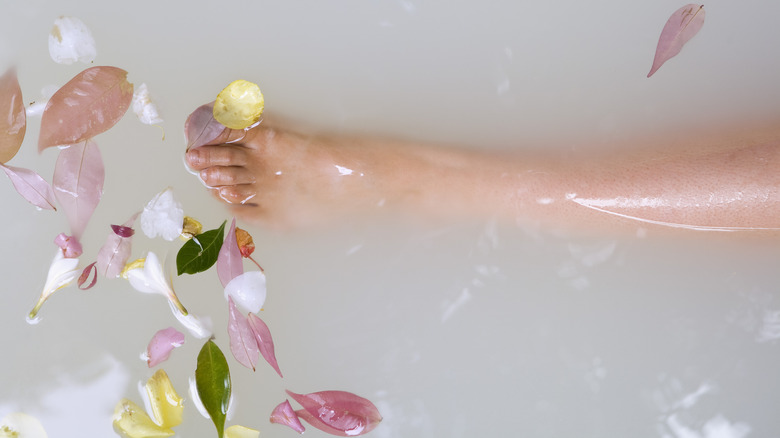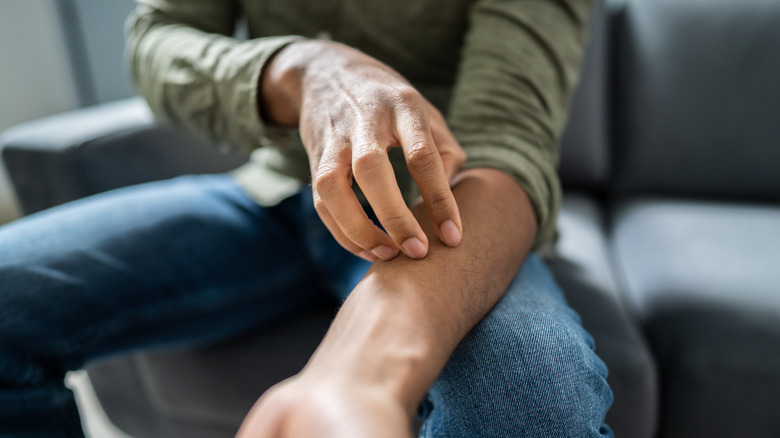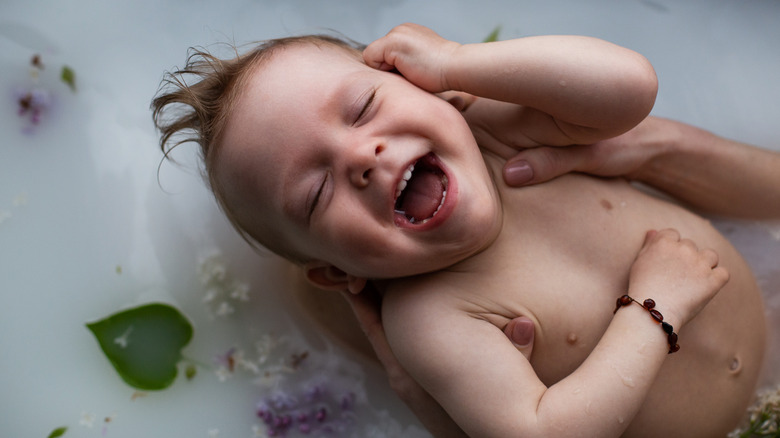Health Benefits Of Taking A Milk Bath
You may have soaked in a bubble bath, oatmeal bath, or an Epsom salt bath, but have you ever submerged yourself in a warm and cozy milk bath? Rather than purely bathing in water, a milk bath involves adding a cup or two of milk into the mix, giving your tub water a soft, cloudy appearance (via Healthline). This can include whole milk, goat's milk, coconut milk, soy milk, or powdered milk, amongst other kinds of milk.
Not only can milk baths be relaxing, but Dr. Michelle Henry, clinical instructor of dermatology at Weill Cornell Medical College, tells Good Housekeeping that milk baths might do wonders for our skin. "Milk baths can have tons of great benefits for your skin. They can soothe and hydrate skin, whether it's dry, itchy, or just generally irritated," Dr. Henry tells the publication. In addition to being packed with hydrating nutrients, milk also contains lactic acid, which serves as an exfoliant and may aid in the removal of dead skin. This may come as great news for those who are susceptible to dry, flaky skin come wintertime. Even better, experts suggest that milk baths may also provide relief from certain skin conditions.
Milk baths may offer relief from various skin conditions
Should you be so unfortunate as to stumble across a patch of poison ivy while hiking outdoors, or spend a little too much time baking in the sun at the beach, a milk bath may be able to help in both scenarios. For cases of poison ivy, a milk bath may help alleviate symptoms of itchiness, redness, and inflammation, reports Healthline. Similarly, a 20-minute dip in a milk bath may help ease the irritation of a sunburn, as milk contains nourishing fats, proteins, amino acids, and vitamins.
Although the evidence is minimal, those with underlying skin conditions such as psoriasis and eczema may also find relief in milk baths. A 2015 study published in the International Journal of Dermatology found that the application of human breast milk and hydrocortisone 1% ointment were both equally as effective at healing infant cases of atopic eczema. However, findings of an alternate 2015 study published in BMC Dermatology saw no improvement in eczema breakouts in kids after human milk was applied to the skin. Therefore, it's always advised to first speak to your doctor when considering trying a milk bath for symptom relief, particularly if pregnant (via Healthline). Experts state that for those with sensitive skin, a milk bath may aggravate the condition. Additionally, milk baths are not advised for those running a fever.
Potential health benefits of milk baths for babies
Rather than using liquid or powdered milk, some experts suggest milk baths may offer both internal and external health benefits for babies when used with a dash of human breast milk, according to Healthline. For example, the antibacterial compounds in breast milk may be helpful in combating baby acne or pesky bug bites. Additionally, the moisturizing acids in breast milk may also help relieve the irritation of diaper rash. Not only that, but experts say that the topical application of breast milk may help fight infection or clear out a blocked tear duct in infants.
If the idea of a milk bath has piqued your interest, experts suggest adults start off by running a warm bath, reports Byrdie. Next, add up to 2 cups of powdered milk. Skincare experts share that buttermilk or whole milk, in particular, are higher in lactic acid. If you're looking to add in a little something extra, try mixing in 1 cup of ground oats, a half-cup of Epsom salt or coconut oil, and top it off with a small splash of your essential oil of choice. However, dermatologists advise individuals to be mindful of any known allergies to specific ingredients and to refrain from use. For optimal health benefits, enjoy your milk bath for a period of roughly 20 to 30 minutes.



